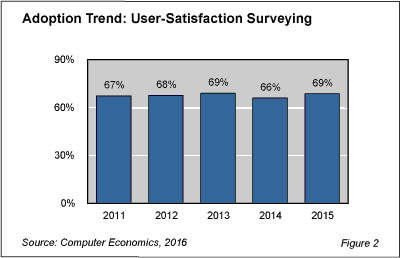CIOs have long been encouraged to manage IT like a business, and customer satisfaction is a key success factor for all organizations. Periodically assessing the satisfaction level of business users is essential to understanding how well the IT organization is fulfilling its mission.
In Figure 2 from our study, User Satisfaction surveying, we see that the percentage of organizations fully or partially surveying user satisfaction rose over the three-year period, from 67% in 2011 to 69% in 2015. The change is relatively small, indicating the practice is relatively mature and slow-growing.

Surveying the level of user satisfaction has become an increasingly critical and therefore standard practice in every industry. Measuring user satisfaction can provide important feedback about the effectiveness and performance of an organization’s internal and external IT resources. If done correctly, surveying users will highlight the strengths and the weaknesses within an IT organization and help prioritize actions for improvement. This type of surveying can measure user satisfaction in such areas as application support and development, desktop support, help desk operations, network service, and IT training.
Many IT organizations struggle with poor user satisfaction. Sometimes the roots of dissatisfaction are within the control of the IT organization: for example, unreliable systems, poor support, and slow response times can create significant dissatisfaction among users. On the other hand, users may have unrealistic demands that go beyond the means of the IT organization to satisfy. The inevitable conflicts also can have more to do with poor communications than poor IT performance. Soliciting feedback from users can not only shed light on where the IT organization needs to improve but also uncover instances where improved communications can reduce conflicts between the IT organization and users.
In the full study, we examine the extent to which IT organizations have deployed user satisfaction surveys and measures the level of organizational engagement in the practice. We look at the percentage of organizations that are partially and fully engaged with the practice. We also look at how adoption of this IT management best practice differs by organization size and sector. Finally, we provide advice on best practices for surveying user satisfaction.
This Research Byte is based on our report on this subject, User Surveying Trends and Best Practices. The full report is available at no charge for Computer Economics clients, or it may be purchased by non-clients directly from our website (click for pricing).

